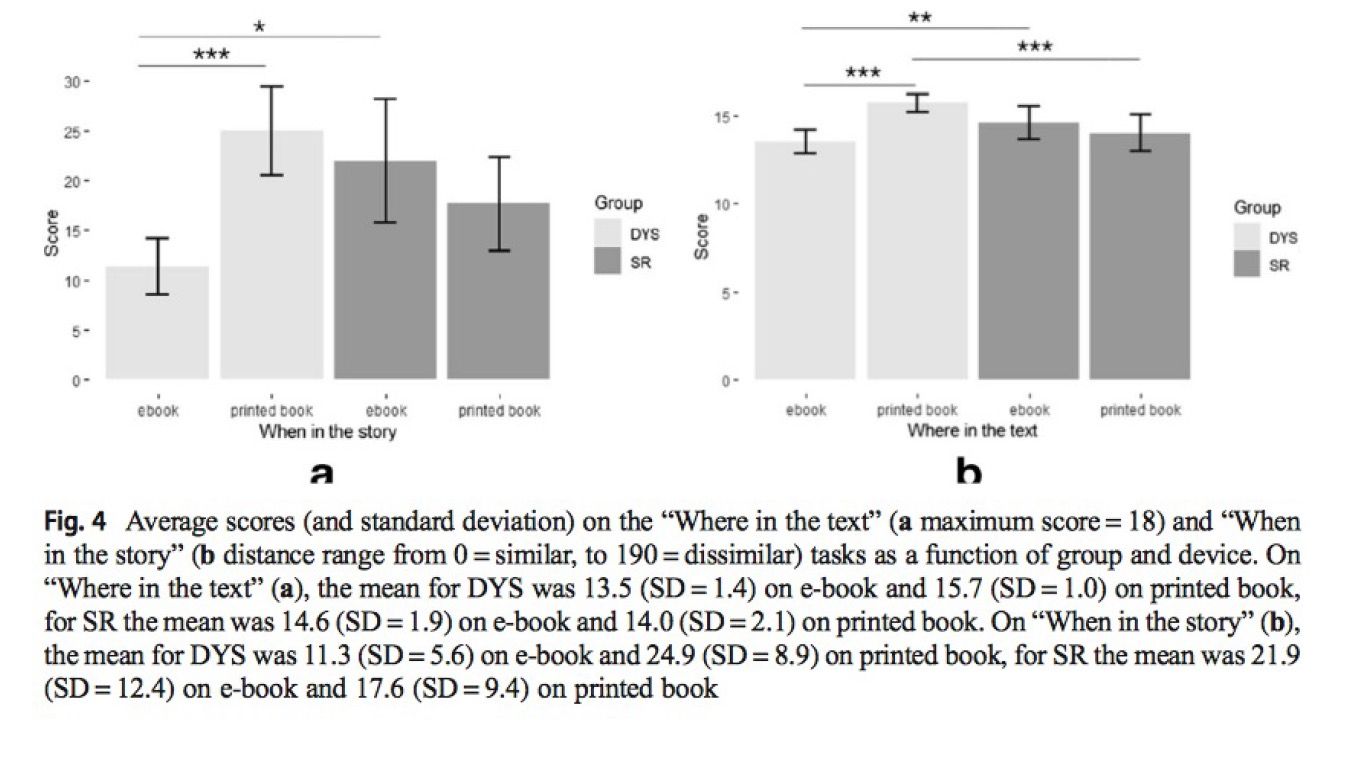Dr. Jean-Luc Velay was kind enough to share his paper called E-book reading hinders aspects of long-text comprehension for adults with dyslexia. The paper’s an important read as there is substantial evidence that reading on a screen and reading a printed book is not the same. There was another surprising finding in the paper (emphasis mine below):
“with the printed book, dyslexic adults performed similarly to skilled readers in both literal and inferential reading comprehension tasks. Moreover, they performed at the same level or higher than skilled readers in tasks assessing spatiotemporal aspects of reading (localization of events and plot reconstruction).”
Look at the data:

Dyslexic college students were BETTER at answering “Where in the text” or “When in the story” questions for a challenging test of over 10,000 words and time flashbacks in the story lines.
The authors of this report don’t offer substantial reasons for why this result was observed, but one could speculate that dyslexic readers experiencing the text as multisensory scenes rather than verbal descriptions might be better able to recall the events as experienced during the reading.
Another major finding of the study is that the college dyslexic group performed worse in the e-book setting compared to print books. This finding does caution educators, schools, and workplaces to not equate reading on paper with computer displays, but to really inform policy, more research needs to be done.
In this study, study subjects had no prior use with e-book reading and they were given a Kindle paperwhite for the e-book situation. The displays were not optimized for individuals (for instance, to reduce visual crowding or reduce the number of words on a page) and font choice and color were also not adjusted for readers’ preferences. The fact that dyslexic readers seem to have more trouble reading on the e-book should make us pause if we had been expecting students or adults should be able to seamlessly transfer reading between the printed page and a digital screen… like a student who is asked being assigned to do Accelerated Reader on a computer terminal or standardized testing.
Some students lose their place more easily because they can’t sweep their fingers across lines of text. These students might fare better if they can use an on-screen ruler like the Google Chrome Reading Ruler.
 Although the findings raise interesting questions, it’s premature to conclude that print books are necessarily better for dyslexic students. This study didn’t look at reading along with text to speech, for instance, or reading with a scanning pen like the one seen in the ad on the opposite page. These formats of reading can potentially improve reading comprehension of complex texts because of the lookup functions on the pen or on computers or mobile devices.
Although the findings raise interesting questions, it’s premature to conclude that print books are necessarily better for dyslexic students. This study didn’t look at reading along with text to speech, for instance, or reading with a scanning pen like the one seen in the ad on the opposite page. These formats of reading can potentially improve reading comprehension of complex texts because of the lookup functions on the pen or on computers or mobile devices.
Some readers may be less efficient with e-books at first as they get accustomed to the different display and formats. If test subjects were frequent readers on the Amazon Kindle, one wonders, would the differences in e-books and print be as great?
Regardless, there were several interesting take-home points from this paper:
1. With print books, dyslexic college students did just as well as skilled readers in both literal and reading comprehension tasks (students were given unlimited time).
2. With print books, dyslexic college students were BETTER than skilled readers with the localization of events and plot reconstruction in the text (students were given unlimited time).
3. Dyslexic college students performed worse with e-books than printed books in this study – but this was their first experience with e-books and no optimization was made regarding the print display.














